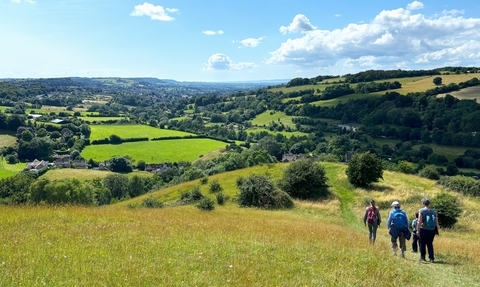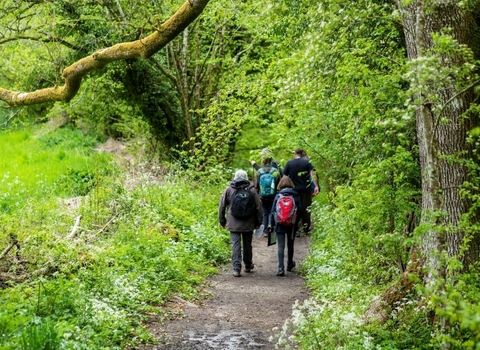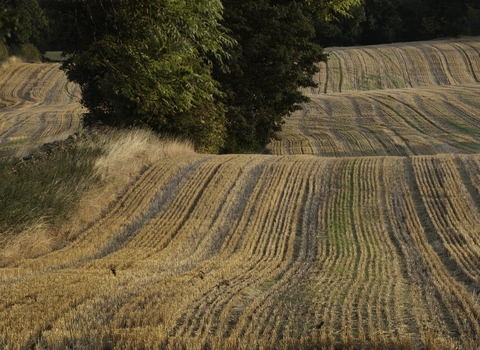
(c) Cawan Andre
HabiMap
Introduction
The HabiMap programme is a collaborative effort bringing together citizen scientists and landholders to map and monitor Gloucestershire’s wildlife habitats.
By working together, we gather valuable data on local ecosystems, helping us make informed decisions for the good of nature. Understanding how habitats connect across the county is key to tackling the ecological crisis, and with the help of our volunteer mappers, we aim to help people feel more connected to nature, too!
Launched in 2020, HabiMap builds upon the foundations laid by the Gloucestershire Nature Recovery Network and Natural Capital mapping project, which provided an initial overview of Gloucestershire's networks of woodlands, wetlands, and open habitats.
While National data sets and satellite data helped create this picture, these have limitations - such difficulties distinguishing different types of grassland from imagery, a lack of detail on habitat quality, and a tendency to be out of date.
HabiMap steps in to bridge these gaps by taking a hands-on approach to updating and refreshing this data, ensuring we have an accurate, up-to-date understanding that supports effective nature recovery efforts.
Current Programme Impact
Since 2021, we have mapped 86.4 km2 of the county, with the participation of 129 landholders and engaged with over 250 dedicated volunteers. The map below highlights the areas we’ve covered so far, but there is still much more to explore. Our goal is to map the entire county and maintain current, accurate data, and we need your help to achieve this ambitious goal!
Areas HabiMapped Across Gloucestershire
How HabiMap Works
Each year, our trained volunteers conduct botanical surveys across various sites in Gloucestershire from April to September. These surveys take place on both publicly accessible land (such as parks or GWT nature reserves) and private land – both always with the landholder’s permission. We value collaboration with landholders, and we are committed to working together to gather important ecological data, ensuring their awareness and consent every step of the way.
Using a mobile app, volunteers record the type and quality of vegetation on-site, categorising parcels of land according to the UK Habitat Classification System (UKHab). The data collected is then centrally stored and processed from October to March, contributing to the county’s digital habitat map held by the Gloucestershire Centre for Environmental Records (GCER).
This updated map enhances our understanding of Nature Recovery Networks, which reveal how wildlife can move across the county, and Ecosystem Services—the essential benefits that nature provides to humans.
Nick Turner
Programme Background
In 2010, the influential ‘Making Space for Nature’ report, commonly known as the Lawton Report, emphasized the urgent need for natural areas to be "Bigger, Better Managed, and More Connected" to effectively halt and reverse environmental decline.
Building on this vision, the government’s 2018 25-Year Environment Plan set out to create a national Nature Recovery Network (NRN) through existing Local Nature Partnerships (LNPs). NRNs are designed to link habitats across the country, enabling wildlife to thrive and move freely.
To ensure these networks are established, the 2021 Environment Act mandated that local authorities develop Local Nature Recovery Strategies (LNRS). These strategies identify key areas for habitat restoration, creation, and enhancement, mapping out priorities to enable nature’s recovery and providing a robust guide for local conservation, planning, and land management.
Gloucestershire Wildlife Trust, as part of the Gloucestershire Local Nature Partnership, played a key role in setting up the Gloucestershire Nature Recovery Network. In 2020, the NRN and Natural Capital Mapping Project produced comprehensive maps, including an Ecosystem Services map and a Habitat map for the county, based on the best available data at the time. However, much of this data was either outdated or lacked clarity.
HabiMap was created to address these challenges, refining our knowledge and ensuring that our efforts to recover nature in Gloucestershire are as effective as possible.
Our Focus Areas
Our aim is to map as much of Gloucestershire as possible, however with limited resources we have identified priority areas for our efforts. Using data from the Nature Recovery Network, Gloucestershire Wildlife Trust has identified certain areas as Nature Recovery Zones.
These zones are key locations where we are concentrating our work to restore and protect local biodiversity. While we are interested in hearing from anyone with suitable land to map in the county, we are especially keen to hear from anyone who owns or knows of land that meets our criteria within these priority zones.
If this applies to you, please get in touch as we’d love to collaborate!
Below is a map highlighting our priority areas.
3 meadow surveyors (c)Nick Turner
Benefits for Volunteers and Landholders
Accurately mapping Gloucestershire’s habitats relies on the invaluable contributions of our dedicated volunteers.
Thanks to their hard work, we can offer free surveys to landholders. Volunteers benefit from comprehensive training, enhancing their botanical expertise, and connecting with a community of passionate individuals.
At the end of the survey season, landholders receive a complimentary report detailing the findings about their land, additional support and advice can be sought from our farming and land management team.
This collaborative effort is truly a win-win for everyone involved—and most importantly, it supports the wellbeing of our local wildlife!
Get Involved
Ready to make a difference? Click the links below to learn how you can join us in mapping and protecting Gloucestershire’s precious wildlife habitats!


